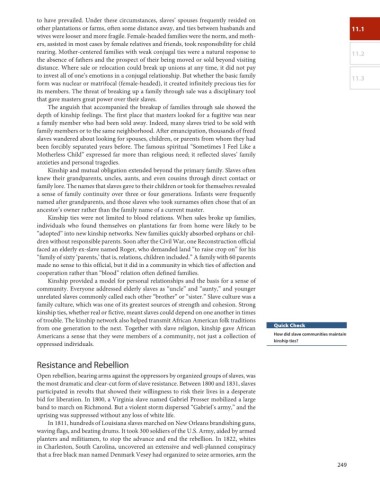Page 282 - American Stories, A History of the United States
P. 282
to have prevailed. Under these circumstances, slaves’ spouses frequently resided on
other plantations or farms, often some distance away, and ties between husbands and 11.1
wives were looser and more fragile. Female-headed families were the norm, and moth-
ers, assisted in most cases by female relatives and friends, took responsibility for child
rearing. Mother-centered families with weak conjugal ties were a natural response to 11.2
the absence of fathers and the prospect of their being moved or sold beyond visiting
distance. Where sale or relocation could break up unions at any time, it did not pay
to invest all of one’s emotions in a conjugal relationship. But whether the basic family 11.3
form was nuclear or matrifocal (female-headed), it created infinitely precious ties for
its members. The threat of breaking up a family through sale was a disciplinary tool
that gave masters great power over their slaves.
The anguish that accompanied the breakup of families through sale showed the
depth of kinship feelings. The first place that masters looked for a fugitive was near
a family member who had been sold away. Indeed, many slaves tried to be sold with
family members or to the same neighborhood. After emancipation, thousands of freed
slaves wandered about looking for spouses, children, or parents from whom they had
been forcibly separated years before. The famous spiritual “Sometimes I Feel Like a
Motherless Child” expressed far more than religious need; it reflected slaves’ family
anxieties and personal tragedies.
Kinship and mutual obligation extended beyond the primary family. Slaves often
knew their grandparents, uncles, aunts, and even cousins through direct contact or
family lore. The names that slaves gave to their children or took for themselves revealed
a sense of family continuity over three or four generations. Infants were frequently
named after grandparents, and those slaves who took surnames often chose that of an
ancestor’s owner rather than the family name of a current master.
Kinship ties were not limited to blood relations. When sales broke up families,
individuals who found themselves on plantations far from home were likely to be
“adopted” into new kinship networks. New families quickly absorbed orphans or chil-
dren without responsible parents. Soon after the Civil War, one Reconstruction official
faced an elderly ex-slave named Roger, who demanded land “to raise crop on” for his
“family of sixty ‘parents,’ that is, relations, children included.” A family with 60 parents
made no sense to this official, but it did in a community in which ties of affection and
cooperation rather than “blood” relation often defined families.
Kinship provided a model for personal relationships and the basis for a sense of
community. Everyone addressed elderly slaves as “uncle” and “aunty,” and younger
unrelated slaves commonly called each other “brother” or “sister.” Slave culture was a
family culture, which was one of its greatest sources of strength and cohesion. Strong
kinship ties, whether real or fictive, meant slaves could depend on one another in times
of trouble. The kinship network also helped transmit African American folk traditions
from one generation to the next. Together with slave religion, kinship gave African Quick Check
Americans a sense that they were members of a community, not just a collection of How did slave communities maintain
oppressed individuals. kinship ties?
Resistance and Rebellion
Open rebellion, bearing arms against the oppressors by organized groups of slaves, was
the most dramatic and clear-cut form of slave resistance. Between 1800 and 1831, slaves
participated in revolts that showed their willingness to risk their lives in a desperate
bid for liberation. In 1800, a Virginia slave named Gabriel Prosser mobilized a large
band to march on Richmond. But a violent storm dispersed “Gabriel’s army,” and the
uprising was suppressed without any loss of white life.
In 1811, hundreds of Louisiana slaves marched on New Orleans brandishing guns,
waving flags, and beating drums. It took 300 soldiers of the U.S. Army, aided by armed
planters and militiamen, to stop the advance and end the rebellion. In 1822, whites
in Charleston, South Carolina, uncovered an extensive and well-planned conspiracy
that a free black man named Denmark Vesey had organized to seize armories, arm the
249

